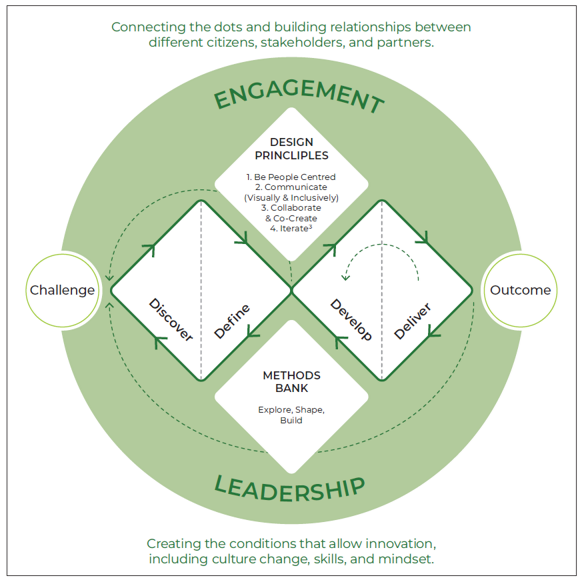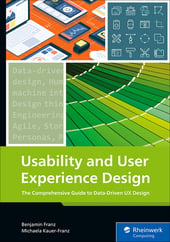The Double Diamond model is another ideal approach to human-centered design projects. This model was developed in 2005 by the British Design Council (2007) and has been used worldwide to structure and guide the work of designers.
The British Design Council views the double diamond as a comprehensive framework that describes the design work process and provides core principles and methods necessary to produce good design work in the long term.
The core idea of Double Diamond is the integration of divergent and convergent thinking. In divergent thinking, a question is considered in detail, and a topic can be dealt with either very deeply or broadly. In convergent thinking, the focus is then placed on individual aspects.
Like design thinking, a wave movement alternates between broad and narrow thinking. The Double Diamond model involves four phases, as shown in the figure below, which we’ll briefly describe.
4

Phase 1: Discover
The first phase, discover, is about deeply understanding the problem. The emphasis is on the difference between guessing and knowing. You’re not making an educated guess exclusively. Instead, you are trying to understand the problem in depth, including its implications for the people involved, and are trying to support that understanding with data.
According to British Design Council, this phase “involves speaking to and spending time with people who are affected by the issues.” You’re not advising; you’re researching.
Looking at the model, you’ll recognize the two diamonds or rhombuses that give the model its name. The discover phase is a phase of divergent thinking because the diamond becomes wider and gets more volume during this phase. So, you can gather a lot of different information and illuminate various aspects.
Phase 2: Define
The second step in the Double Diamond model focuses on defining to avoid drowning in the sheer volume of data. You must draw the story you want to believe and follow from the data. Now is when your skill at analyzing data comes in: You must understand what story the data has to tell.
From our experience with many aspiring and experienced UX professionals, we can say that this step is probably one of the hardest. Understanding patterns in data requires a lot of practice and analytical skills. Nevertheless, this step is necessary because, without deriving the pattern, you’ll always remain at a level that makes it challenging to design your system, product, or service.
For example, a typical uncondensed statement would be, “3 out of 10 people I’ve talked to want feature Z.” As long as you don’t understand the underlying need behind the desire for feature Z, you’ll constantly develop what are called feature solutions, which can be pretty good—but for which a large amount of uncertainty always remains in the development as to whether they are outstanding.
The define step is designed take time to specifically analyze the data and derive the design task from it. The define step is a convergent thinking step where you narrow the mass of available information into a few core results. Note that define does not mean you can pick and choose what data to use! Define means that you recognize the pattern in the data and select the pattern that the data fits. The define phase concludes the first diamond of the Double Diamond model.
Phase 3: Develop
After clearly defining and naming the problem in the previous phase, you’re now thinking broadly and looking for solutions. This phase is about working out which possible solutions might be suitable for your problem.
As in many other creative fields, the focus is on collaborative solution finding. “Collaborative” means working with different people, perspectives, and professional backgrounds. Furthermore, inspiration from other places (e.g., similar problems, comparable solutions, parallels in nature) should be sought and integrated.
This creative divergent phase is followed by another convergent phase. We’ll take a closer look at this phase in the next section.
4
Phase 4: Deliver
In the final phase, deliver, the goal is to select and implement the best solution from the many available and possible approaches. The deliver phase is iterative. In this step, all solutions are implemented as prototypes. The focus is again less on technical implementation and more on making the solution approach tangible from the user’s perspective.
Simple user tests take place to again collect real opinions and data on the solution approaches. All approaches that don’t work are removed. All approaches that generally work are further improved, and the best approach is finally (technically) implemented.
Key Principles
In addition to the four phases, the Double Diamond model is based on several underlying principles. For completeness, we’ll also briefly mention some of these key principles:
- Put people first.
- Communicate visually and in an integrated way.
- Work together and collaborate.
- Iterate, iterate, iterate.
Behind the first key principle, “Put people first,” is the belief that a deep understanding of the problems, needs, strengths, and hopes of the people involved is the basis for finding successful solutions.
People are visual and can grasp graphical information much faster than textual information. Therefore, the second key principle emphasizes visual communication to create a shared understanding for all parties (both designers and users).
The last key principle, “iterate, iterate, iterate,” describes once again that the first solution will not be the final solution and that testing ideas is necessary to detect errors early on to avoid getting stuck on an idea.
Conclusion
The charm of the Double Diamond model lies in its simplicity. True to the core discipline of the British Design Council—namely, design— the model is simple, appealing, and easy to use. The four phases are logically structured and easy to follow but comprise various possible steps and methods. The British Design Council even offers a collection of methods on its website for each phase. More information can be found at https://www.designcouncil.org.uk/.
Editor’s note: This post has been adapted from a section of the book Usability and User Experience Design: The Comprehensive Guide to Data-Driven UX Design by Benjamin Franz and Michaela Kauer-Franz. Benjamin received his doctorate in engineering; his UX-related dissertation on highly automated driving was awarded the Walter Rohmert Research Prize. In his jointly founded and managed company, Custom Interactions, he focuses on user interface design. He also works as a lecturer and a keynote speaker. Michaela has a doctorate in psychology with a focus on product design and user experience. Together with Benjamin Franz, she founded the data-driven UX agency Custom Interactions, which they manage together. She also contributes her extensive experience as a trainer, a lecturer at Technische Universität Darmstadt, a speaker, and on an International Organization for Standardization (ISO) committee.
This post was originally published 7/2024.




Comments